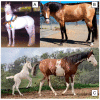Spotting the Pattern: A Review on White Coat Color in the Domestic Horse
- PMID: 38338094
- PMCID: PMC10854722
- DOI: 10.3390/ani14030451
Spotting the Pattern: A Review on White Coat Color in the Domestic Horse
Abstract
Traits such as shape, size, and color often influence the economic and sentimental value of a horse. Around the world, horses are bred and prized for the colors and markings that make their unique coat patterns stand out from the crowd. The underlying genetic mechanisms determining the color of a horse's coat can vary greatly in their complexity. For example, only two genetic markers are used to determine a horse's base coat color, whereas over 50 genetic variations have been discovered to cause white patterning in horses. Some of these white-causing mutations are benign and beautiful, while others have a notable impact on horse health. Negative effects range from slightly more innocuous defects, like deafness, to more pernicious defects, such as the lethal developmental defect incurred when a horse inherits two copies of the Lethal White Overo allele. In this review, we explore, in detail, the etiology of white spotting and its overall effect on the domestic horse to Spot the Pattern of these beautiful (and sometimes dangerous) white mutations.
Keywords: coat color; depigmentation; horse; mutation; white spotting.
Conflict of interest statement
Authors A.M., K.M., M.V., R.E.E. and C.L. are affiliated with Etalon, Inc., which offers genetic testing for many pigmentation-related variants, including the variants described in this review.
Figures








References
-
- Bailey E., Brooks S.A. Horse Genetics. 3rd ed. CABI; Wallingford, UK: 2020.
-
- Grilz-Seger G., Neuditschko M., Ricard A., Velie B., Lindgren G., Mesarič M., Cotman M., Horna M., Dobretsberger M., Brem G., et al. Genome-Wide Homozygosity Patterns and Evidence for Selection in a Set of European and Near Eastern Horse Breeds. Genes. 2019;10:491. doi: 10.3390/genes10070491. - DOI - PMC - PubMed
Publication types
LinkOut - more resources
Full Text Sources

